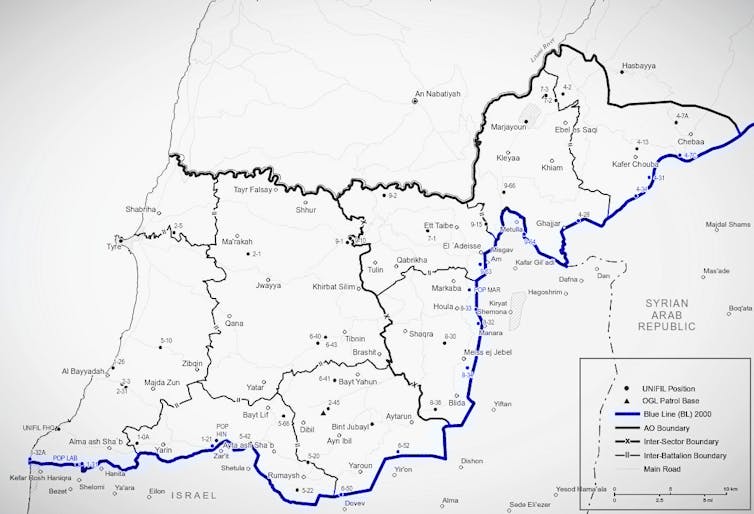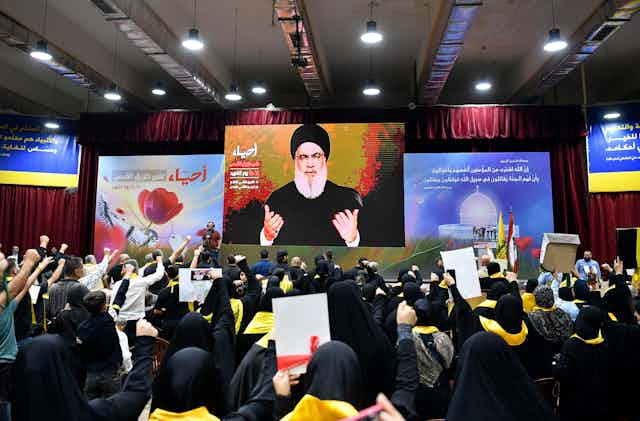While the attention of the world has focused on Israel’s assault on Gaza over the past two months, following Hamas’s attack on Israel on October 7, one aspect of the Middle East conflict not getting a great deal of news coverage has been the continuing battle with Hezbollah in south Lebanon.
There have been daily reports of clashes between the Israeli army and Lebanese Hezbollah. On December 11, nine Hezbollah attacks on Israeli towns or military positions were recorded. The group, whose name means “Party of God” and which is largely funded by Iran while embedded in Lebanon, has lost more than 100 fighters since October 7.
Hezbollah and Hamas are thought to collaborate as part of the broader “axis of resistance”, which also includes the Houthi rebels in Yemen and other groups in Syria, Iraq and Iran. While there is no evidence that Hezbollah was directly involved in the planning for the October 7, logistical training and coordination between Hezbollah, Hamas and the Iranian Revolutionary Guards has been going on for years.
One example of this cross-pollination of ideas is the “Gaza metro” – the extensive network of tunnels built by Hamas throughout Gaza. These are generally thought to have been masterminded by Hezbollah commander Imad Mughnieh and Iranian commander Qasem Soleimani, who was killed in a US airstrike on Baghdad in 2020.
Party of God
Hezbollah has its roots in the Israeli invasion of Lebanon in 1982 when Israel occupied all of south Lebanon as far as Beirut in its attempt to root out the Palestine Liberation Organisation.
After Israel withdrew from Beirut, it continued to occupy large amounts of territory in the south of Lebanon. In 1985, Hezbollah announced itself with an open letter published in the Lebanese daily newspaper, al-Safir, stating its mission as a resistance movement against US imperialism and Israeli occupation.
In the 1992 general election, Hezbollah’s political wing won eight seats, giving it the largest block in the Lebanese parliament and establishing the group as a major political force.
In 2000, after repeated Hezbollah-led operations against the Israeli military, Israel withdrew its troops from most of southern Lebanon – up to what was called the blue line, a UN-designated “line of withdrawal” which delineates Israeli territory from Lebanon and the Golan Heights and is policed by the United Nations Interim Force in Lebanon.

It is at best a sticking-plaster solution, as Israel still occupies areas – such as the Shebaa Farms and seven other villages, that Lebanon considers to be part of its territory.
In July 2006, after a brief military confrontation across the Lebanese border, Hezbollah captured two Israeli soldiers sparking a month-long war between Israel and Lebanon during which more than 1,000 Lebanese people were killed and 150 Israelis. Israel also conducted a massive campaign of airstrikes, including targeting the southern suburbs of Beirut, known as Dahiyah in Arabic.
The conflict eventually led to a prisoner swap between Israel and Hezbollah, yet it exemplified a new strategy by the Israeli military which became known as the “Dahiyah doctrine”. This held that the disproportionate use of airstrikes for which the destruction of military targets was not the main aim – the goal was to change a population’s hearts and minds.
The doctrine was explained in 2008 by the then-commander of the Israeli army, General Gadi Eizenkot, who told an Israeli newspaper in 2008: “We will wield disproportionate power against every village from which shots are fired on Israel, and cause immense damage and destruction. From our perspective, these are military bases. This isn’t a suggestion. This is a plan that has already been authorised.”
Eizenkot is now a member of Benjamin Netanyahu’s war cabinet. He has lost both a son and a nephew in the current conflict in Gaza.
To show the axis of resistance that it will stop at nothing to impose its will on Palestine, the Israeli military is using “disproportionate force” in Gaza as a key part of its strategy.
Balance of terror
The main point of difference between previous clashes between the Israeli military and Hezbollah is that most of the recent battles have taken place inside Israel. It’s a key development. The legacy of the 2006 war between Israel and Hezbollah has been what has become known as the “balance of terror”.
Hezbollah leader, Hassan Nasrallah, has said publicly that had he known what the outcome of the 2006 raid in Israel that captured two Israeli soldiers and led to the second Lebanon war, he would not have approved it. Israel knows, too, that launching a ground war in Lebanon would also be disastrous.
From 2010 until today, clashes between Israel and Hezbollah have mainly been confined to Israel’s military targeting convoys of weaponry sent by Iran and its killing of Hezbollah members.
Hezbollah announced in February 2022 that it had acquired the technology to build high-precision guided missiles that reach targets across the whole of Israel and could pose a threat to its Iron Dome defence system.
Regionally, Hezbollah and Iran’s allies in the axis of resistance have concentrated their attacks on US bases through Iraq, Syria and Yemen. This is a deliberate strategy aimed at putting pressure on Washington to, in turn, pressure Israel to agree to a ceasefire.
In a speech delivered on November 3, Nasrallah articulated Hezbollah’s strategy. Attacks in northern Israel were aimed at dividing the focus of the Israeli military between defending Israel’s borders and its operation in Gaza. Meanwhile, he said, attacks on US bases in Iraq and Syria would continue.
Nasrallah gave another speech on November 11 calling on Arab nations to put pressure on Washington to end Israel’s occupation of Palestinian territories. Meanwhile Hezbollah, with help from allies in Iraq, Iran, Yemen and Syria would continue to launch attacks on Israel.
“We will continue with this,” Nasrallah said. “We will increase the quantity, quality and depths of our operations. The people in Lebanon support the resistance … What happens on the battlefield is more important than words.”

